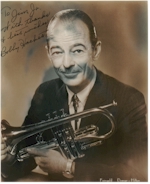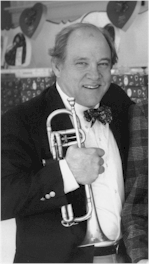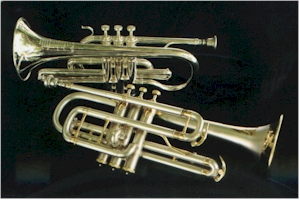After about two years of fascinated
blowing with my first cornet, I
began to think of a new horn. The
original had served me well--a 1910
C. Bruno and Sons model that I
purchased from a San Antonio pawn
shop. The negotiated price had been
$7.
But now I had my eye on a new horn,
as one day I walked into the C.
Bruno and Sons San Antonio office
and came face to face with a brand
new French Besson Brevette cornet.
I had briefly met Fred Hoy, absolute
ruler at C. Bruno. He was a cornet
player himself. He went “mm, mm, mm”
and then “yum, yum” as he studied my
old horn. “You know," he said
slowly, “if you like these short
cornets, you should see what we just
received,” and with that he whipped
out the French Besson. I could only
say “wow” and repeated it several
times, for to this day I’ve never
seen a more beautiful cornet. The
story goes that Ed Sonfield, owner
of Bruno, was strolling on a Paris
street one day in the late 1950s
when in amazement he was stopped in
his tracks as a cornet lamp was
grouped with other oddities in a
window display at a small store. The
cornet was a pre-war French Besson.
Ed rushed in and purchased the lamp
with the intention of scrapping the
lamp portion and saving the great
cornet. As the shop owner counted
out the change, Ed asked “Why would
anyone make a lamp out of such a
great instrument?” “Oh that,” came
the reply, “I have twenty-four of
those cornets in the basement and
can’t sell them, so I finally
started making lamps. The lamps at
least sell a little!”
Within another 30 minutes C. Bruno
and Sons was seriously in the French
Besson cornet business. The entire
collection was sent to cornet
virtuoso Byron Autrey at Michigan
State. Byron, an expert, saw to it
that all the Bessons were silver
plated and that all the valves were
lapped perfectly. All were large
bore (467 thousandths of an inch),
and many consider them among the
greatest cornets of all time.
So I was off with my beautiful
French Besson and it wasn’t long
until, to my delight, I discovered
that one of my idols,
Bobby Hackett,
was playing this same cornet and had
used it on his famed
Coast Concert recording.
These cornets were beautifully
engraved and silvered and each came
with a case made of genuine
alligator.
I would probably have been happy to
play the French Besson for the rest
of my days had not the Landing
audience one night contained Sandy
Sandberg, sales manager for the
newly organized Getzen Co. of
Elkhorn, Wisconsin. Sandy pushed a
new Getzen cornet into my hand and
bingo, I had a new lover. The
Getzen’s design was influenced by a
rare 1950s Conn cornet and by the
French Besson, and I always thought
the designer had been both smart and
lucky. Getzen made up a large bore
model just for me and I was a Getzen
“artist” and advocate for 25 years.
During all that time Getzen more or
less took over what there was of the
American cornet market.

Portrait of Bobby Hackett holding his Getzen cornet. The inscription reads: "To Jim, Jr. With thanks & best wishes, Bobby Hackett."
In 1968 Bobby Hackett arrived in San
Antonio to record with our band, and
as he unpacked, out came a shiny
Getzen cornet. Hackett had been
seduced just as I had. But Hackett
was fickle about cornets, and the
next time I saw him he had a Benge
cornet and then an Olds that had
belonged to Red Nichols.
At one point, Bobby decided to go
into business with some fellows who
were developing a sound component
store located in New York City. It
was called “Bobby Hackett’s Sound
Stage.” Bobby would say, “I always
wanted to be in business. Come on
over and see my office.” Soon, when
I was in New York I went to see
Bobby, who was set up with a private
office at the rear of the sound
component store. The investors did
the work, Bobby just lent his name
for a small part of the ownership.
As I was shown in, Bobby rose from a
large polished desk. He was in high
spirits and we visited. Conversation
soon turned from his new business to
our mutual fascination, cornets.
“I’ve gone back to the French
Besson,” he said. He seemed to
change about once a week.
In addition to Bobby’s desk, the
only furniture in the office was a
large filing cabinet. Bobby
approached it and pulled on a
drawer. Expecting to see a bank of
traditional file folders, I did a
double take for the entire cabinet
was jammed with cornets, six drawers
full!
I have never been as nutty as Bobby
Hackett about my search for the
ultimate cornet. However, I do carry
the "cornetaholic" gene, and
fascinating cornets seem to be out
there waiting for me to chase them
down odd pathways.
One evening Bruce McKinley, a
friendly “bloke,” approached, giving
himself away with his Australian
accent. I affected a “g’day” and he
gained inner circle access by
identifying himself as a friend of
Bob Barnard, the great Australian
cornetist. Not only is Bob a great
cornetist, he is, with the passing
of Armstrong and Hackett, clearly
the greatest jazz cornetist in the
world. At least that is my strong
opinion.
So, Bruce and I were off yakking,
when he asked, “Do you know of any
hock shops around here? I want to
buy an old cornet.”
I did a fast mental geography
search. “Well, there are hock shops
but maybe you should try the Army
Navy store. It’s located just a few
blocks away and I pass it every
night en route to the Landing, and
hanging from the rafters are all
kinds of old horns--trombones,
tubas, saxophones and lots of
cornets. I avoid the place like a
reformed drunk avoids a bar!”
The next night he was back
questioning me, “Have you ever heard
of a cornet by C.G. Conn?”
“Of course, they were the greatest
makers in the old days.”
“Well over at that Army Navy store
they have an odd cornet by C.G.
Conn.”
“What’s odd about it?” I asked.
“This one has a vertical tuning
slide.”
I jumped a little. “Hey Bruce,
that’s a Conn Victor--right at the
top of the list. Beiderbecke played
a Conn Victor! You’d better go back
and grab it!”
“Oh,” he groaned, “my wife has
everything planned. She wants me to
take her to Austin and then to the
Hill Country. I’ll be doing my best
just to get back to hear one of your
evening sets.”
I protested, “It’s a Conn Victor
man, I’ve been looking for one all
my life. Maybe I’d better go and get
it, and we’ll work it out later!”
The next morning saw me casually
looking over cornets at the Army
Navy store and feigning disinterest
in the old Conn Victor. Finally I
asked, “How much for this old
Conn?”
“Two hundred dollars,” came the
reply.
“Sold,” I cried, no longer able to
conceal my excitement.
Bruce showed up that night as I was
wailing on the Victor. “I see you
got the cornet,” he said, “how is
it?”
“Oh Bruce, it’s a gas. I paid $200,
but it’s for you. Just give me $200
and it’s yours.”
“No” he
said, “you like it, you should keep
it.”
We were like Alphonse and Gaston
saying, “After you, no you.”
“Look Bruce,” I said, “you found it,
you should take it.”
Looking a little sheepish he finally
confessed, “Jim, all I’m going to do
is make a lamp out of it!”
I stood back soaking in this new
information. “Well in that case, I’m
keeping it.”
The great Conn Victor set my playing
off in a new direction. Its huge
bore is an amazing 484 thousandths
of an inch (the modern standard for
cornets and trumpets is 460
thousandths of an inch). So, the
Conn Victor was a different blow, as
even the most extreme large bore
modern horn never exceeds 470
thousands of an inch, and it took a
while to get the volume of air just
right.
The Conn Victor is easy to spot
because of the “vertical tuning
slide” Bruce spoke about. So over
time, a variety of listeners noticed
it and would step forward with old
Conn Victor cornets that had
belonged to their grandfather or
someone, and had been stored in an
attic for 50 years.
Generally unable to resist another
Conn Victor, I gradually have
amassed about twelve of them and the
number is still climbing. Still, not
one plays as well as the one Bruce
found at the Army Navy store.
After Bruce and his wife had seen
enough of the bushes and rivers of
central Texas they moved on to
looking at bushes and rivers in
Louisiana and eventually bushed and
rivered themselves all the way to
New York City. Along the route Bruce
had found his lamp cornet, but his
forward momentum still had him
keeping a sharp cornet eye out.
He was excited on the phone. “I’m in
New York City and there’s a music
shop that has a gold plated 1928
model Conn Victor.”
“Thanks Bruce,” I answered with a
new passion in my voice, “I’ll be in
New York in a couple of weeks and if
it’s still there I’ll be on it.”
Following Bruce’s directions I went
to W. 48th Street. In
those days that neighborhood was
still throbbing with music stores,
repair shops and teaching studios,
and I always found it charming to
wander around there. Usually a
trumpet or trombone or two could be
heard practicing from some hidden
window. I found the address and
climbed a steep stair to discover a
world of sales and service of used
instruments. The name read A.
Morini, and Mr. Morini himself was
holding forth with his strong
immigrant Italian accent.
Finally, I started in, interrupting
him as mildly as I could. “I
understand that you have a gold
plated Conn Victor cornet for sale.”
“Well, I did have that cornet for
sale for about a year until
yesterday, but Wynton Marsalis, he
came in and then he bought it.”
Later I heard Wynton never plays the
Conn and it's probably gathering
dust--or maybe he’s made a lamp out
of it!
After about ten Conn Victor years,
fate took me to Portland, Maine to
play two nights with the Portland
Symphony. Carl Bradford, a trumpet
player, soon to become a good
friend, met me at the airport and
showed me around Portland. Later, he
and his wife provided oil skin
slickers and we all went out to the
craggy Maine coast where we sat out
on the rocks and feasted on steaming
Maine lobster just taken from a
boiling pot. They were such splendid
hosts. Naturally, when Carl asked if
I’d give him a quick trumpet lesson
I was pleased to comply and soon we
were in his basement working on our
lowest and highest notes.In the
process he showed off a beautiful
1914 Buescher cornet.
“Play it a little,” he said, “and
let me hear how you sound on it.”
It was all innocent enough, but then I went head over heels again over another cornet. “What a horn,” I exclaimed as I handed it back, “What a horn!” Its bore size was .489, even larger than the Conn Victor. But, the Buescher wasn’t for sale, and several years passed before it arrived one day via United Parcel Service. A note was enclosed from Carl: “I’ve finally decided to play only trumpet,” it said, “the Buescher cornet bore is too large for me. If you don’t want it, send it back and I’ll make a lamp out of it.”



